|
FIRST MINBURN SCHOOL
|
|
The first public school session in Minburn was
taught by Dan Morrision in the hall over Warford's Store. Then a little
later, a farmer's wife from Dallas Center, Mrs.
Wm. Snell, taught a total of two in a building on Walnut Street - near
the Ullery store.
In 1874, Hannah Yard taught in the new school house on a corner of
Walnut Street.
She wrote what served as a blackboard in the early days, "Order is
Heaven's First Law."
Some of the other early teachers were: Emma Larimer (Mrs. M.W. Gibbons),
Lizzie Sprague, Lizzie Lyon, Hattie Silvers, Emma Moore (Mrs. E.R.
Aiken), Alzina Hiatt, Jennie Hill - for many, many years D.F. Rogers,
Samuel H Lauder and A.T. Whitmer. Wages ran from $20 to $35 a month.
Country districts paid $27 to $40 a month.
A second building was added for the Primary department. It stood north
of the main school house. The winter term begain Oct. 20, 1879, with 23
scholars. By January some more came from the country and there were 75
pupils. Some of them were: Laura Record, Maggie Oakland, Mattie Warford
(Mrs. Ed Bryant), Jennie Hill, Flora Gillam, Fred Anders, Iva Anders,
Julia Rogers, Andy Record, Eddie Hill, Lewis Rogers and Carrie Warford.
|
|
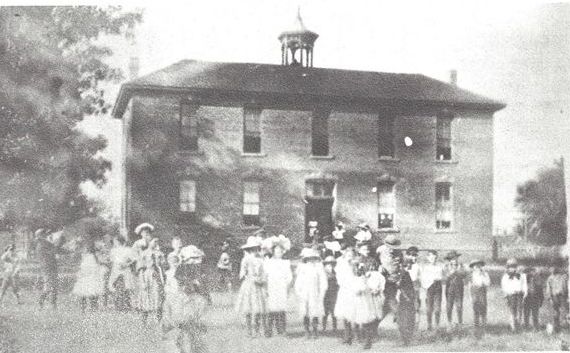
This old MINBURN SCHOOL was located just west of
the present school building.
|
|
EARLY SCHOOLS
|
|
The first office for County Superintendent
of Schools was established in April, 1858, at Penoach, an Indian word
meaning in the English language "Far Away". That settlement is now the
present site of Adel. James O. Reed served as Superintendent from April,
1858 to June 1859.
Statistics show during the year of 1858 that $2089.16 were drawn from
the school funds of which Sugar Grove Township received it portion.
We have been unable to procure any records pertaining to the time of
organization of a school board. However, we do find a record of a usual
meeting that was held for this district, March, 1875, at Center School
House, near Minburn. The following officers were elected: Samuel
Edmondson and William Minnis each to serve as a director for a term of
three years; J.O. Warrington and W.P. McClure for a term of two years;
Thos. Stevens and Samuel Hose for a term of one year. W.P. McClure was
appointed as president; A.J. Lyons as treasurer and S. Kenworthy for
secretary. The school Board then voted to hold seven months of school
each year; three months during the summer and four months during the
winter.
The Township Board of Directors was made up of a director from each
school.
June 5, 1875, the school board voted to fence the school yard and to
arrange for the planting of trees. Sept. 30, 1887, the school board
purchased from Thomas hill a strip of land five rods wide and nine rods
long for the sum of $7.00. This land was acquired for the purpose of
increasing the size of the school yard to one acre.
March 21, 1887, the school board voted to permit William Wicks to have
an addition of 10 x 20 feet made to the school house. This addition was
completed on December 10, 1892, at a cost of $199.27. John O'Brian was
the teacher.
During November, 1910, a box supper was held and entertainment given in
the school house to raise funs for the construction of a belfry on the
building. Stella Smithers Miller was the teacher.
August 22, 1927, the school house was moved to the southwest, away from
the main road. The door at the east was closed and an opening made for a
door at the south. Helen Nissly was the teacher.
In June 1929, this school house was sold to E.O. Miller and moved from
the school grounds.
|
|
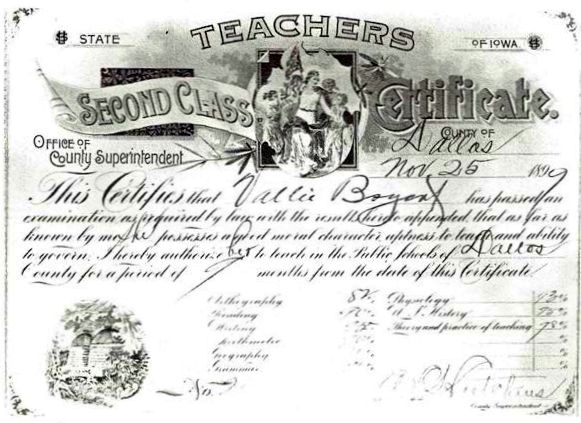
Vallie Bryant is the name on the certificate, Nov
25, 1899.
|
|
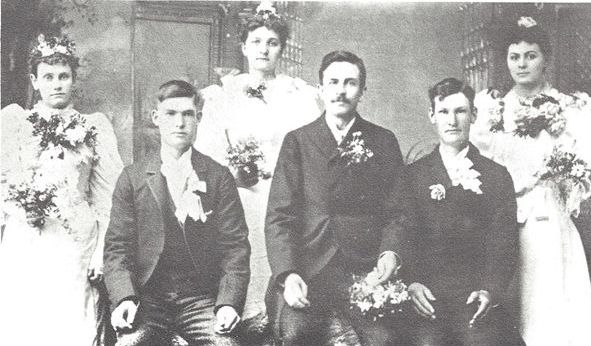
|
|
Pictured above is the third graduating class from
Minburn School, ninth grade in 1896. The three ladies are, from left:
PEARL BARGER, VALLIE BRYANT, and GRACE MUCK. the men are: WILL SHIRLEY,
SAM EMMERT, and TOM SHRLEY.
|
|
FIRST SCHOOL IN SUGAR GROVE TOWNSHIP
|
|
The following history of the first school in
Sugar Grove Township was written by Mrs. Pearl Birdsall. Luther
Slaughter took her all around the country, hunting up early settlers and
search records.
"The records have been searched and we find after careful investigation
that the first school house in Sugar Grove Township was built during the
year 1854, and known as the Fremont School House.
"The last surviving scholars who attended this school were Susan Bell
Kimmery, Eraline Bray Landis, Louise Cartwright Campbell, and Mary
Cartwright Temple.
"Mark Newby, a true illustrious church-going bachelor, who settled here
in 1852, donated one corner of his claim for this school house. It was a
crude structure about 16 feet long built of logs, and had a sod and
stick chimney which stood on one side of the building. The fireplace
occupied nearly one end of the entire house. Its windows or light holes
were made by cutting an opening on each side of the room about two or
three feet in size. A rustic latch-string door hung on wooden hinges
fronted the south. A row of wooden pins was placed in the logs around
the insides in each chimney corner on which to hang the scholars' slat
sunbonnets and head shawls. The construction of this building was
supervised by Joshua Wilson and the labor contributed by the settlers.
Its antique desks were made of rough boards hewn from logs and supported
by wooden pins which extended from the logs. These desks stood at the
sides and north of the room and next to the wall.
The school house was completed during the month of August, 1854. School
was opened the following month and Harriet Sutton employed as teacher.
She was paid $20.00 by subscription for her services, for a term of
three months. Her board was provided by the patrons of the school.
The teacher occupied a rugged desk near the center of the room. From
here she laid down the rigid law of the rod, and when he could not be
prevailed upon to obey, a peculiar method was applied by the teacher.
She would tie a rope about his waist and suspend him from the rafters.
Here he was left to be ridiculed by the more obedient boy or girl.
When the hour came for study, the children reluctantly occupied the
seats without backs. At his desk the scholar struggled over reading,
writing and spelling, which was the extent of the learning at that time.
One McGuffy's reader and one elementary speller sufficed for a dozen
children. Thumb-papers, a small folded piece of paper was held under the
thumb to protect the book while reading. A small rough board made black,
hung on the wall from a wooden peg. On this board the teacher made her
copies for the scholars to copy on their slates. Later, ink and pen were
used. The ink was made and donated by Sarah Cartwright, who settled here
in 1850. It was made by boiling bark from the hickory tree and made
black by mixing the liquid from copperas. Pen points were tied to sticks
or feathers which answered the purpose of penholders.
The drinking water was carried from a pond a short distance from the
schoolhouse in a cedar pail, and passed to the children in a dipper made
from a gourd, by cutting out the side and using the stem for a handle.
The scholars' dinners consisted of luscious corn bread spread with
sorghum. As a delicacy they added plum butter. This they carried in
homemade baskets woven from willows.
Wood for the great fireplace was hauled from the dense forests and
donated by the settler. When the irksome task would be neglected by the
careless parent, school would be closed for several days.
Often during the long cold winters the weird cries of wild animals would
be heard as they prowled about the schoolhouse seeking shelter from the
storm. Then, too, sometimes at night, the old log school house would
become a place of gay activity where the young folks gathered and held
their spelling matches and singing school. They spelled and sang by the
dim light of a grease lamp. This lamp was made by using an iron plate to
hold the grease that soaked a twisted rag which extended from the side
of the plate.
This place was also the scene of many a spirited political feud. Here
the barefoot settlers would sit for hours and discuss the topics of the
day, occasionally displaying their plugs of homegrown tobacco. Later
these became anxious meetings. Bitter words spoken in moments of
political heat were forgotten and they all formed in one great cause
when the Civil War broke out. Many were the heartaches and tears when
the boys from school went forth and bravely answered their country's
call.
On Sundays the fathers and mothers with their children all dressed in
home-made suits made from wool and flax occupied the seats for Sunday
School and to listen to Peter Russell, a half-breed Indian, expound the
gospel.
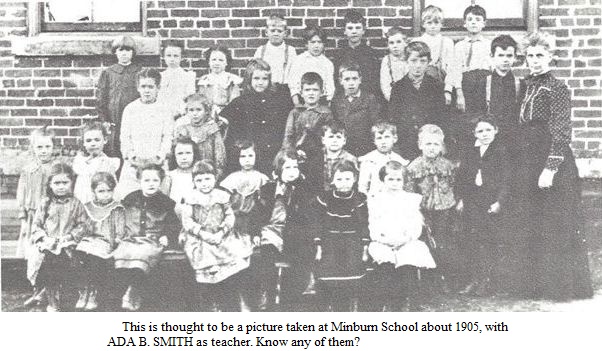
|
|
With the passing years came Stafford Campbell,
Clayborne Wright, William Yeager and Lydia Perkins who taught in the log
schoolhouse. Finally the boys of the district school met and decided
that it was time to dispense with the old dilapidated schoolhouse. So
one dark night they carried coals of fire and as one boy set fire to the
building, the others guarded. Soon the old school house passed into
oblivion.
Two years elapsed. During this period school was held in a vacant house
which had been occupied by Mark Newby and his sister. This house was
located in the edge of the timber, about 50 rods southwest of the log
school house. John Paddock was employed as teacher.
About the year 1870, a frame school house was erected on the present
site, which is 60 rods northwest of the log schoolhouse. This land was
owned and donated by Thos. Bill whose honest dealings and frank genial
manner made him a great favorite among the settlement. Samuel Gitzy was
the first teacher in this school house.
|
|
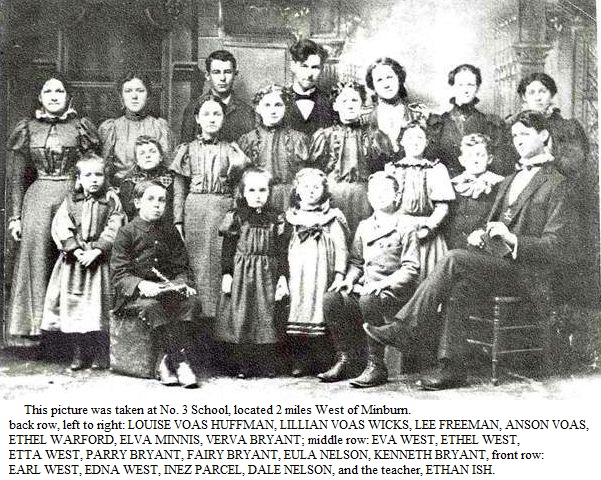
|
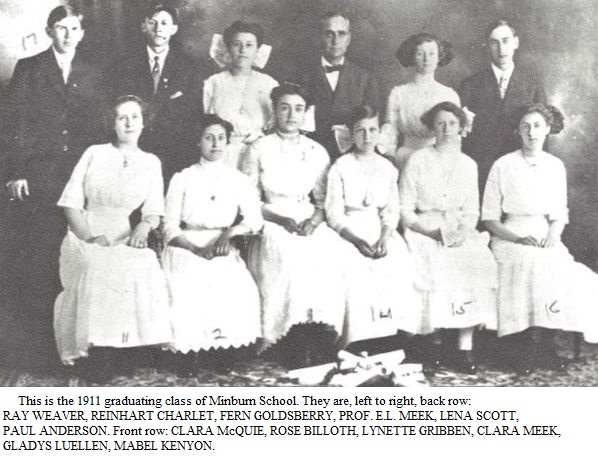 |
|

|
|

MINBURN SCHOOL 1916
|
|
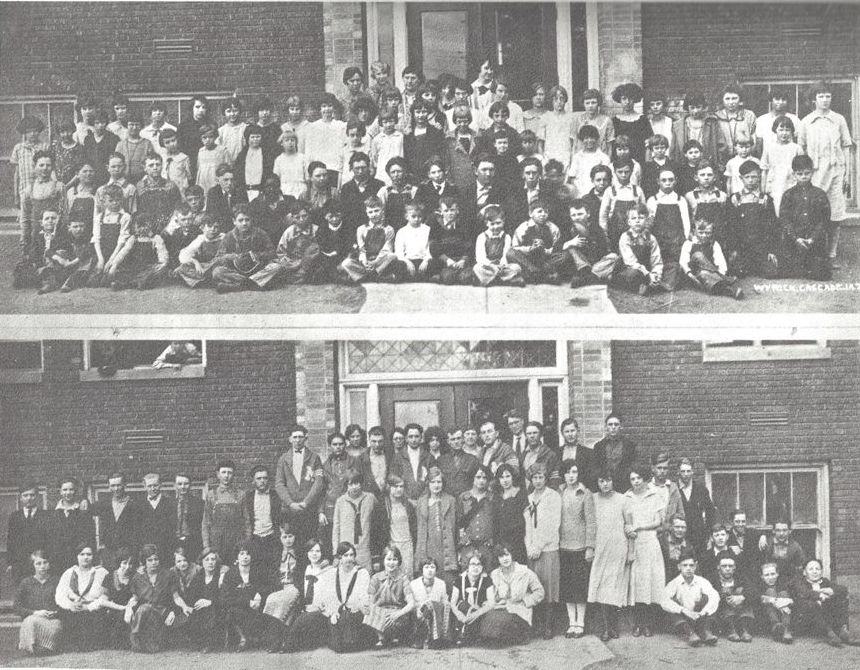
MINBURN SCHOOL 1925
|


